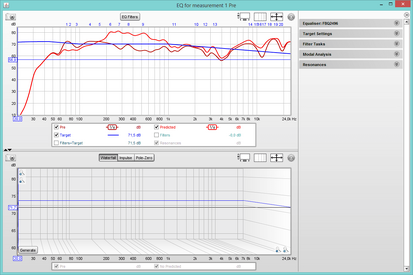Countcobolt
Registered
Thread Starter
- Joined
- Dec 31, 2017
- Posts
- 10
Hi all,
I am trying to measure my studio for better sound performance. Let me first describe my setup:
I am running a focusrite Scarlett 18i20 hooked to a FBQ2496 to 2 ADAM A7X speakers. On the speakers there are small modifiers for sound, but I placed them all to flat.
I am trying to set up the FBQ so that my frequencies are flat overall (for mixing and mastering purposes). I use an ECM8000.
Steps I have done:
1. I have calibrated my sound card (connect output 1 to input 1 for that).
2. I struggled with a loopback, it appears that the sound coming from out 5 to in 5 on the sound card is really low
3. I loaded the ECM8000 calibration file
Until this is appears ok with the exception of 2.
When I started to measure (1M Log, 8 sweeps) I can adjust the Q/Gain/Freq in the EQ filter to be mostly flat. (I will add pictures later). But the first thing I noticed was that the high is very sharp and low is also too much. When I measured the room again with ARC2 my hunch was confirmed.
So I started to do a few more things :
1. Measure the room with the BFQ in bypass
2. Create new filter
3 Remeasure the room with BFQ active
4. Modify the filters from the first measurement to get better results.
5. repeated 3 and 4 multiple times.
Although that the predicted line from REW sets that my Mid will be too much, as my high, the remeasurement with the BFQ active seems to be quite flat. Is this normal?
Also what kind of smoothing do you apply? I currently use 1/6.
Kind regards
Steve
I am trying to measure my studio for better sound performance. Let me first describe my setup:
I am running a focusrite Scarlett 18i20 hooked to a FBQ2496 to 2 ADAM A7X speakers. On the speakers there are small modifiers for sound, but I placed them all to flat.
I am trying to set up the FBQ so that my frequencies are flat overall (for mixing and mastering purposes). I use an ECM8000.
Steps I have done:
1. I have calibrated my sound card (connect output 1 to input 1 for that).
2. I struggled with a loopback, it appears that the sound coming from out 5 to in 5 on the sound card is really low
3. I loaded the ECM8000 calibration file
Until this is appears ok with the exception of 2.
When I started to measure (1M Log, 8 sweeps) I can adjust the Q/Gain/Freq in the EQ filter to be mostly flat. (I will add pictures later). But the first thing I noticed was that the high is very sharp and low is also too much. When I measured the room again with ARC2 my hunch was confirmed.
So I started to do a few more things :
1. Measure the room with the BFQ in bypass
2. Create new filter
3 Remeasure the room with BFQ active
4. Modify the filters from the first measurement to get better results.
5. repeated 3 and 4 multiple times.
Although that the predicted line from REW sets that my Mid will be too much, as my high, the remeasurement with the BFQ active seems to be quite flat. Is this normal?
Also what kind of smoothing do you apply? I currently use 1/6.
Kind regards
Steve















